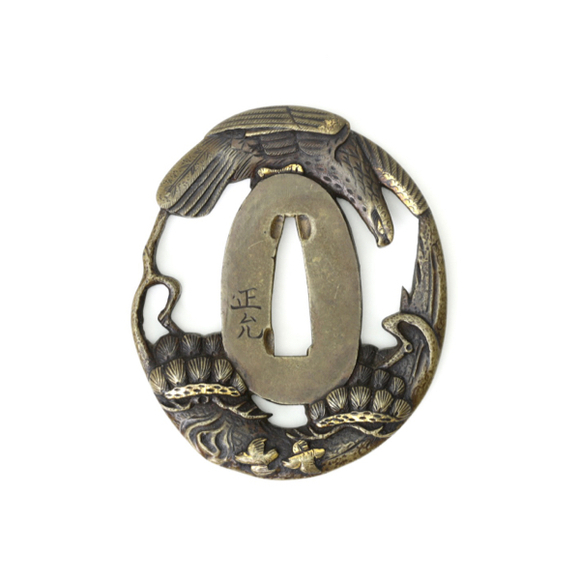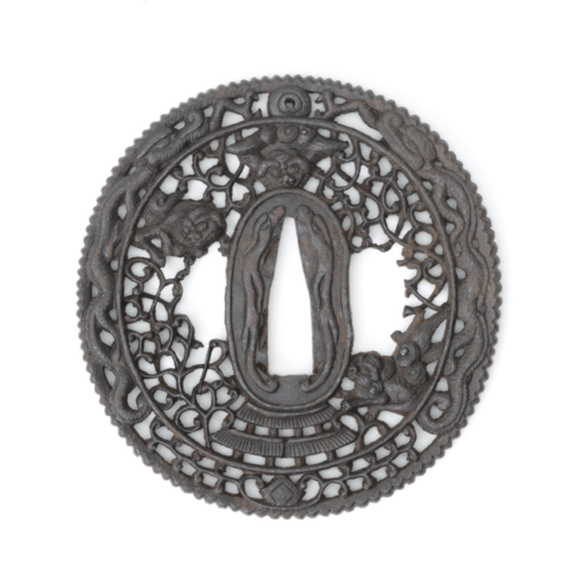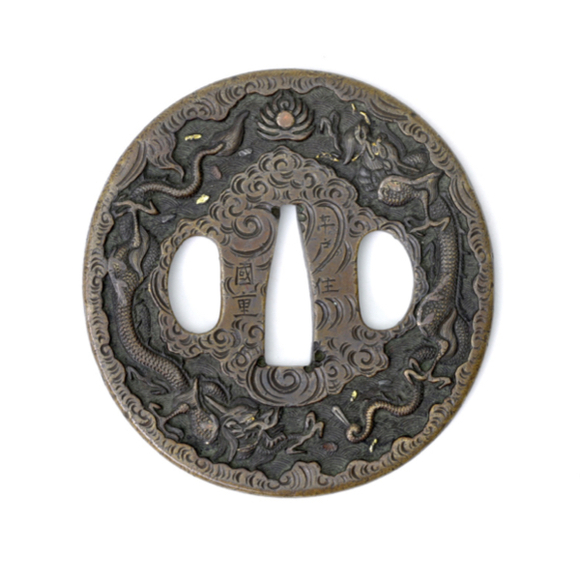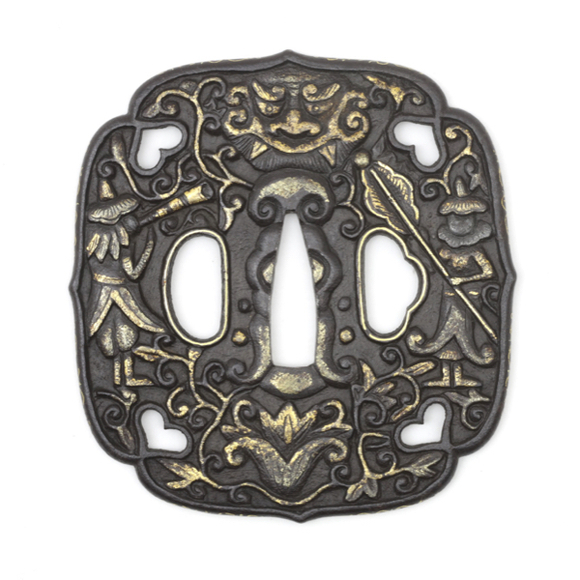Russet iron, one-piece construction with decorative grooves.

Mounted 89 cm
Blade 72.5 cm
Nagasa (edge length) 57.3 cm
Base 6.9 mm
At tip 4.2 mm
Base 28 mm
Tip 18.8 mm
Sori 19 mm
Blade 480 grams
With hilt 770 grams
11.5 cm from guard
Blade: Tempered steel
Mountings: Wood, green mother of pearl dust, urushi lacquer, sea shells, gold, shibuichi, copper, glass
Echizen, Japan
Blade circa 1673-1681
Mountings probably early 19th century
From a European private collector
Introduction
The Japanese sword comes apart after removing a single pin in the hilt. Parts were easily switched, and as a result, most fully mounted katana on today's market are composites, with parts matched at a later date. Rarely do we find a full matching koshirae that was perfectly fitted to a blade. Today, I'm happy to be able to present such a complete Japanese sword.
Description
A very flamboyantly mounted sword, showing nothing of the normally rather austere taste of Japan's samurai class. It was probably custom-made for a wealthy individual with eccentric taste.
The blade by Echizen Kanesada. His swords are considered was mono, an old Edo period ranking granted to smiths who made swords with excellent cutting ability.
The blade is in an old polish, with some corrosion damage here and there and some tiny nicks. Although out of polish, we can see that it is forged in nie-deki (with large shimmering martensite crystals). The hamon is more wave-like than normally seen from this smith, nicely matching the wave theme of the mountings.


The nakago is signed:
上野守藤原兼定
Kōzuke no kami Fujiwara Kanesada
Lord of Kōzuke (province), Fujiwara Kanesada
Echizen Kanesada
Kanesada was active in Echizen around the Enpō period, 1673-1681. He was the successor of a previous Kanesada who moved from Mino to Echizen to work under Echizen Kanenori.
Kanenori in turn was also originally from a Mino line, but they moved to Echizen because the demand for swords from the Mino area diminished after the beginning of the Edo period. One of his swords was signed as having been made in a field camp at the Battle of Sekigahara of 1600, a decisive battle in Japanese history that ended the Sengoku period and established the Tokugawa Shogun as ruler of Japan.
See Markus Sesko; Swordsmiths of Japan. Lulu Publishing, 2015.
Noble titles like Lord of Kōzuke were granted to the better swordsmiths of the Edo period. The tradition harks back to a time where the emperor wanted to learn how to forge swords, but could not drink tea with lowly commoners. He then granted some notable bladesmiths noble titles so he could mingle with them and learn their craft. These titles were purely ceremonial, they did not have actual power over these provinces as the noble daimyo class did.
Horimono
The fine dragon horimono on the blade shows workmanship that makes it attributable to the Kinai group of Echizen. They were famous tsuba makers and horimono carvers, known for their detailed carving. A good horimono could surprisingly cost as much as a good sword. See Markus Sesko's Breakdown of price for a sword blade.


There is a stylized lotus and bonji on the other side.
Symbols related to tantric Buddhism.
Koshirae
The sword comes in a beautiful mother-of-pearl lacquered scabbard, inlaid with cross-sections of a red, unidentified natural material. Probably a species of nut. On the back of the scabbard is a flat facet, inlaid with a number of different sea shells, some seen in cross-section.

The tsuka is wrapped with blue-green silk over golden carp menuki with glass or stone eyes.



The fuchi and kashira are in the famous style of Ōmori Teruhide, with deeply carved waves with golden bubbles.
The fuchi is signed Sōmin [kao].
The scabbard mounts are all en suite, its end piece (kojiri) showing a dragon among powerful waves in very high relief. This mount is signed Masatatsu [kao].

It comes with kōgai (hairpin) and kozuka (by-knife) in the same style as the hilt mounts.

The unsigned tsuba is less deeply carved, yet its dragon and waves are a stylistic match to the rest.
Sōmin and Masatatsu
Both Sōmin and Masatatsu have roots in the Yokoya lineage. The first-generation Yokoya Sōmin was initially employed by the ruling Tokugawa clan but resigned to work for the wealthy merchant class instead, where he enjoyed more artistic freedom. He was to become the most influential carver of his day. His line continued in this direction, showing more flamboyant work that doesn't conform to the Shogunate's more restrained taste.1
The style of the mounts reminds strongly of the work of Ōmori Teruhide, whose line is closely connected to the Yokoya school as well. In fact, it was the first generation Yokoya Sōmin who was the teacher of Ōmori Terumasa, father of Ōmori Teruhide, who pioneered the style of waves we see here. Their workshops were nearby, and the two families seemed to have kept a close connection.2
The Sōmin signature seen on this fuchi could be that of a later generation, perhaps the 6th or 7th.3
Masatatsu, full name Seiseisai Yamasaki Masatatsu (⻘生斎山﨑政辰) was trained by Yokoya Terukiyo. There is a theory that the Masatatsu mei written (正辰) is an earlier signature of Masatatsu (政辰). He also trained with the Ishiguro School and was allowed to use both names in his work.4
Notes
1. Wakayama; Tōsō Kodōgu Kōza 3 Edo Kinkō Hen (Jō). 1972.
2. Markus Sesko; Genealogies of Japanese tsuba and tōsō-kinkō Artists. 2011.
3. Markus Sesko, personal communication.
4. Wakayama; Tōsō Kodōgu Kōza 3 Edo Kinkō Hen (Jō). 1972. Also see Markus Sekso; Signatures of Japanese Sword Fittings Artists. Lulu, 2014. Page 214.
Conclusion
A highly unusual and high-quality ensemble, probably entirely custom-made for a wealthy individual with eccentric taste. He brought a number of very fine craftsmen together for this task, who delivered a very high-quality sword in all regards. A 17th century blade by the wazamono-rated smith Echizen no Kami Kanesada, with horimono of the famous Kinai group of iron carvers.
The en-suite mounts, including the kogai and kozuka, are excellently crafted in the style of the famous Ōmori Teruhide by a later-generation Sōmin carver. The kojiri is made by a different maker who was trained by the same lineage.
The scabbard treatment with green mother-of-pearl dust lacquer and inlaid red nuts are possibly unique to this piece. No-one in my network, including some seasoned Japanese lacquer restorers, had ever seen anything quite like it.



































Unusual tsuba with foreign figures and Chinese auspicious symbols.






